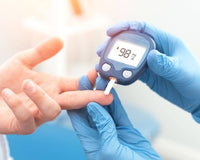Cold sores, sometimes referred to as fever blisters, are small, sometimes painful, fluid-filled blisters that appear around the lips and mouth. They are a common viral condition most often caused by infection from the herpes-simplex virus. Cold sores can also be triggered by stress, viral infection, fatigue, changes in weather, and injury. In the following article we answer the question what causes cold sores. We also discuss six common triggers of cold sores and cold sores treatment.
What Are Cold Sores?
Cold sores, also known as fever blisters, are small, fluid-filled blisters that appear around the lips. They are a common viral infection. More than half of the United States population has been infected with a virus that causes cold sores during their lifetime.
Cold sore blisters are often grouped together in small patches. After these blisters break, scabs form. Cold sores usually disappear in two or three weeks and rarely leave any permanent marks.
What Causes Cold Sores?
In most cases, cold sores are caused by strains of the herpes-simplex virus, or HSV. HSV can be transferred by kissing someone who has the virus, engaging in oral sex, or sharing utensils, towels, and razors with a virus carrier. Herpes-simplex virus is very common; around 90 percent of adults in the United States have HSV antibodies in their bloodstream.
Once infection occurs, the herpes-simplex virus may recede and remain dormant for extended periods of time. However, cold sores may reappear if the virus is triggered by an external or internal source. Common triggers of cold sores include changes in environment, hormonal changes, and injury.
What Causes Cold Sores On Lips?
Cold sores on the lips are caused by infection from herpes-simplex virus type 1. This virus can be spread through kissing, oral sex, or sharing items that often touch the mouth, like utensils and straws. The appearance of cold sores on the lips may be preceded by a tingling sensation around the lips.
What Causes Cold Sores On The Inside Of The Mouth?
Cold sores usually appear on the lips and around the mouth, but in some cases, cold sores can appear on the inside of the mouth. A prolonged outbreak of cold sores may cause them to spread to the inside of the mouth. Cold sores that appear on the inside of the mouth may be easily mistaken for canker sores, small shallow lesions caused by injury and stress. Unlike cold sores, canker sores have no connection to the herpes-simplex virus.
Common Triggers Of Cold Sores
After initial exposition, the herpes simplex virus lies dormant in the body’s nerve cells. Once dormant, the virus may emerge again and lead to the reappearance of cold sores on various parts of the body. Changes in health and environment can sometimes lead to a reemergence of cold sores. If cold sores reappear after lying dormant for a while, it may be due to one or many of the following six reasons.
Viral Infection
Viral infections such as the flu can reignite cold sores. Cold and flu viruses can compromise the immune system, leading to the reappearance of cold sores.
Stress
Mental and physical stress can affect the entire body, including the immune system. When the immune system is compromised, dormant cold sores have a chance to reappear and wreak havoc in the form of blisters.
Fatigue
When you are fatigued, their immune system and protection often becomes weaker. This decrease in protection can lead to infection and make you vulnerable to cold sores. When you feel sick or fatigued, it is important to practice healthy habits such as getting an adequate amount of sleep and eating a healthy diet. These practices may be able to prevent an outbreak of cold sores.
Cold Weather
Dry air during winter can cause your lips to crack and break, making them more vulnerable to cold sores. Additionally, the cold temperatures of winter can make the body less effective at fighting viruses. If the body’s immune system is compromised due to cold weather, it is more likely for cold sore infection to occur.
Exposure to Sunlight or Wind
For some people, exposure to bright sun can trigger cold sores. The ultraviolet radiation present in sunlight can affect the entire immune system, making viral activity, including cold sores, flare up. Some researchers also believe that exposure to sunlight can actively stimulate the herpes virus, increasing the likelihood of a cold sores outbreak. When the dormant herpes virus is stimulated, it often moves from the nerve cells to the mouth, causing an outbreak of cold sores.
Injury to the Skin
After the initial symptoms of herpes-simplex virus infection go away, the virus often recedes to then lay dormant in nerve cells. A cut or injury to the skin can cause damage to nerve cells, allowing the herpes simplex virus to reach the skin again, often leading to the appearance of cold sores.
About Cold Sores Treatment
Cold sores can be treated through at-home remedies and prescription medications. Popular prescription drugs used to treat and mitigate outbreaks of cold sores include acyclovir, famciclovir, and valacyclovir. Common home remedies such as sunscreen, ice, and aloe vera may also be effective at reducing and managing cold sore outbreaks.
Cold Sore Causes: Summary
Cold sores are small, sometimes painful, fluid-filled blisters that appear around the lips and mouth. They are a common viral condition most often caused by infection from the herpes-simplex virus.
After initial infection, cold sores may recede and lay dormant for extended periods of time. Cold sores can reemerge if triggered by viral infection, stress, sunlight, cold weather, or injury.








